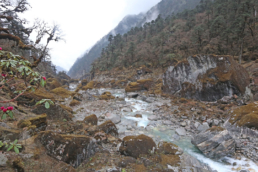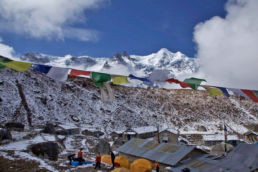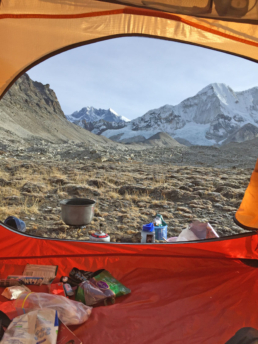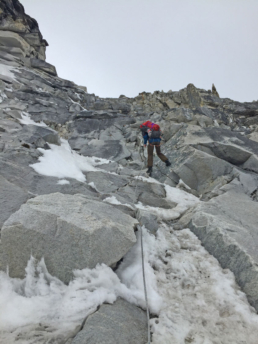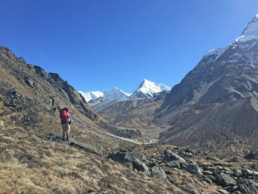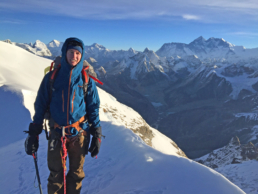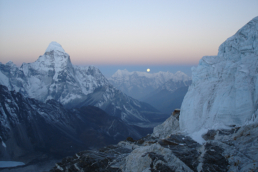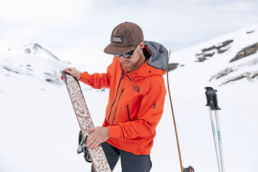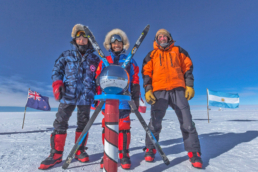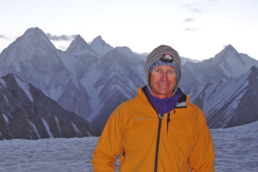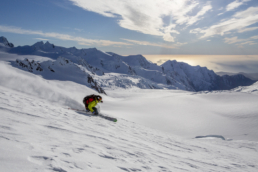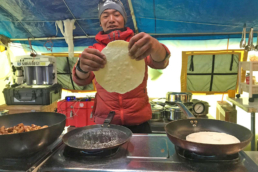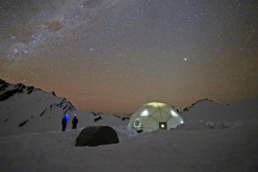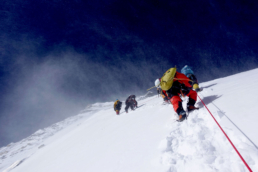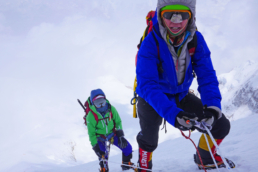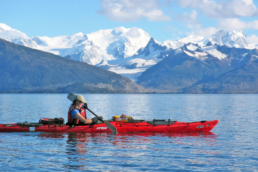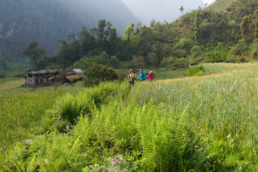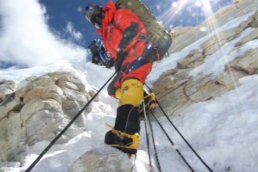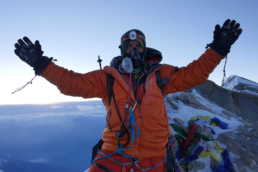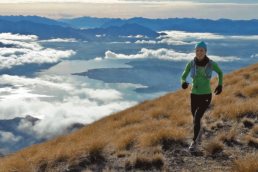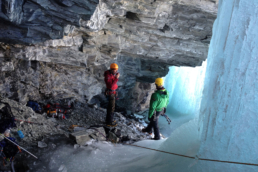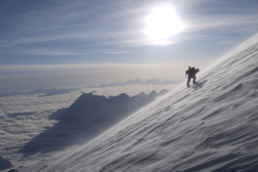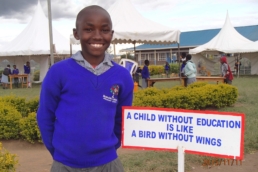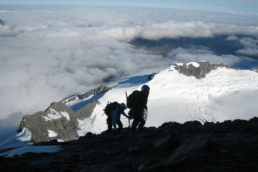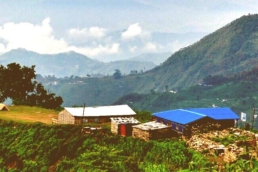A journey to Mera Peak and Amphu Lapcha Pass
Words and images by Lillian Cotter
Mera Peak has long been renowned as a magnificently remote, yet relatively achievable introductory Himalayan climb. Accessed by a wild and wonderous trek through forest and rural settlements to the gentle slopes of Mera Peak in the heart of the Himalaya. Spectacular scenery and stupendous views abound! AC staffer Lillian Cotter and friend Craig Murray, recently undertook the journey to climb Mera Peak, taking adventure to the next level by including a traverse of the challenging Amphu Lapcha Pass from the Honku Valley into the Imja Valley, creating an adventurous two week circuit.
Day 1 Lukla (2,860m/9,383ft) to Chutanga (3,430m/11,250ft)
Duration: 4 to 5 hours
The first day of the trip finally rolled around! Booted up and ready to go at 6am, the organised chaos unravelled in Kathmandu airport. We waited hopefully on a weather clearance as the rain started to ease. By 12.30pm we had taken off in two planes, been re-scheduled three times and had finally buckled into a helicopter as a last resort due to no fixed wings flying! With an exciting helicopter ride behind us, we made it into Lukla by 2pm, had a bite to eat at one of the local tea houses and were enroute to Chutanga with our porter by 3pm! With a fair bit of cloud creeping up the valley behind us, we started the trip with a continuous view back towards Lukla. The track was beautiful, weaving its way around the hillside through waves of pink rhododendrons and crossing several calm river beds with jumbling boulders. The mist eventually began to catch up with us as the skies darkened and we arrived into Chutanga around 7pm, found our lodge and settled in for the night.
Day 2 Rest and acclimatisation day
We took advantage of a sleep in and slow morning before heading off for an acclimatisation walk. We had a few pockets of sun as we followed a nearby river most of the way up to a small village at about 4,000m/13,000ft. This active rest day aided our acclimatisation, as we climbed upwards another 700m/2,300ft from our height the previous afternoon, in anticipation of tomorrow’s climb over the Zatrwa La Pass.
Day 3 Zatrwa La Pass (4,600m/15,100ft)
Duration: 7 hours
We woke up to a screamer of a day, with clear skies at 6am! We had a quick breakfast and set off for the Zatrwa La Pass, eager to make the most of the clear weather. The beautiful morning afforded us great views down valley, with Lukla still in sight but slowly disappearing as we trekked closer towards the pass. After 3 hours of cruising up reasonably steep terrain we made it to 4,600m/15,100ft, the top of the pass. Unfortunately, views from the top were obscured due to cloud, so we carried on down, wrapping around the ridge for about 20 minutes before we began to drop down towards the valley floor. With time up our sleeves, we lingered in the small village of Thuli Kharka (4,200m/13,800ft), enjoying tea and snacks at a local tea house, before continuing on towards Chetarwa (3,580m/11,745ft). We passed a few oncoming groups on our way and spent some time stalking birdlife alongside the trail. As we dropped further down into the valley, the landscape returned to hillsides of tall forest, rhododendrons and incredible views to distant mountains.
Day 4 Chetarwa – Khote (3,700m/12,140ft)
Duration: 2 hours
With a short walk today, we packed up and headed to a leisurely breakfast at 8am, leaving Chetarwa at 9am. Low cloud hung to the valley walls and it was a moody walk down through the forest to the heaving Ingkhu Khola river. The trail meandered parallel to the river, making for a relatively easy day’s trek. We reached Khote before lunch and spent the afternoon relaxing and exploring the area.
Day 5 Khote – Tangnag (4,250m/13,940ft)
Duration: 3 hours
Again, we had a nice gradual day as the trail followed alongside the river bed, with incredible surrounding forest and moraine terrain. Gaining about 700m/2,300ft, we rolled into Tangnag late in the morning, with the sun coming out during the last half hour of the walk. The scenery was starting to change, as we saw more views of the snow-covered peaks surrounding us.
With much of the day free, we checked into our lodge near the end of the village and thought we would scope out the possibility of a glacial bath! In luck, we headed up river from the track and enjoyed a freezing, but much needed wash. Feeling healthy and comfortable at 4,250m, we decided to skip our planned rest day and move onwards to our next stop, Khare, the following day.
Day 6 Tangnag – Khare (4,800m/15,750ft)
Duration: 3.25hr
We awoke to clear skies at our lodge this morning! Feeling good (all things considered), we decided to push on through Khare after breakfast. We took our time trekking, as the trail steepened in parts, and not far along we were rewarded with panoramic views and an incredible lake vista. The views took our minds off the gradual steepening of the trail and we saw an impressive avalanche before heading over the hill to Khare. It’s here at Khare that teams prepare for their ascent of Mera Peak. The small collection of lodges and camping spots was located with a stunning backdrop of snow-capped peaks and Mera beckoning not far from the village! We spent the afternoon checking and preparing equipment for our ascent.
Day 7 Khare – Mera High Camp (5,800m/19,030ft)
Duration: 5 hours
The plan for today was to push through to Mera High Camp, following a trail from Khare through to Mera La and onwards to the High Camp, nestled into the rocky mountainside at 5,800m. We left Khare at 8.30am with beautiful clear skies, reaching Mera La within a couple of hours, where we stopped for a snack and got sun smart before heading out onto the snow.
It was a warm, gradual walk up to high camp, with occasional steep sections fixed with ropes and amazing views back to Everest and Makalu. It really felt like were in the Himalayas! After establishing camp, we had a standing dinner, watching the sunset over the incredible mountain ranges surrounding us. Early night for an early rise the following morning.
Day 8 Mera High Camp – Mera Summit – Kongme Dingma
Duration: High camp to summit and back 4.5 hours (in perfect conditions and the track kicked in)
High camp – Kongme Dingma 3.5 hr
Alpine starts are never easy! Waking at 1am we melted some ice and forced breakfast down. The temperature was about -5◦C, so not too bad. We left high camp at 2.20am, with a beautiful star-filled sky, perfect conditions and followed a track already kicked into the snow. The route was quite a long gradual track with some steep sections. The sun began to rise at 4.30am and we parked up briefly to warm up our feet and take in the surrounding views. We continued on, reaching the summit at 5.30am. After absorbing the views, hydrating and having a quick snack we started the descent, arriving back into high camp at 7am.
The day was far from over though, and while we ate and napped for a short time, we contemplated the next stage of our trek to Kongme Dingma. At 10.30am we left Mera High Camp and headed down, dropping off the glacier onto mixed terrain and a lot of downhill! I was feeling it in the knees! At 1.30pm we arrived at Kongme Dingma and set up camp.
Day 9 Kongme Dingma – Honku Valley
Duration: 7.5 hours
We had an early rise, waking to clear skies and sun, so it was the usual porridge for breakfast and we headed off at 7.30am. Half an hour into the walk we passed a beautiful alpine lake, stopping for a swim and much needed wash, we carried on dropping into the Honku Valley. The airiness of the remote valley was calming and the gradualness of this leg of the trip allowed us to tinker along, taking everything in after the grind up Mera. The trail passed several incredible glacial lakes and we stopped for lunch beside one before deciding to carry on further to get closer to the pass. Pushing through, we set up camp just below the last grind before Amphu Lapcha Base Camp. From here we had views of Everest and Lhotse. Arriving just before hail and rain came in, we were thankful to be rugged up in our sleeping bags as we watched the weather pass through.
Day 10 Honku Valley – Chhukung
Duration: 10 hours
Camping being beside a beautiful lake, we naturally skipped some stones as we breakfasted and packed up camp. By 8am we were underway once again, negotiating the final steep section to Amphu Lapcha Base Camp within a few hours. With the weather looking a little iffy we had some quick snacks and decided to head over the pass. After talking to a group that had crossed the pass the previous day, we learnt that fixed ropes were already in place, meaning we had time on our side. Scrambly moraine took us to the bottom of the icefall where we broke briefly to don our crampons for the snow and ice sections ahead of us.
There were three sections of fixed ropes to negotiate to the top of the pass, followed by a small fixed traverse that took us across the pass to the Khumbu side. From here, the descent involved some abseiling, but soon it was off the ropes and onto a steep, exposed track heading down the valley.
Getting down to flatter ground, we stopped for a rest and looked back up at the pass. From here it looked formidable! It was quite a long walk to finish off the day but the change in terrain brought flatter ground and more easy-going walking. We had great views of the nearby Island Peak, beautiful glacial lakes, and we were starting to see some life and plants again. Arriving into the seemingly busy hub of Chhukung with the mist at 6pm, we were well ready to put our feet up and have some kai!
Day 11 Chhukung – Everest Base Camp (5,300m/17,400ft)
Duration: 6 hours
After several early starts, we took a restful morning, enjoying the sun and a leisurely breakfast. We made it as far as Dingboche before stopping for an early lunch at 10.30am and somehow not leaving until 12pm!
We soon joined the well-trodden trail to Base Camp, passing through Lobuche (4,940m/16,207ft) where we ordered waffles while being entertained by an American school group. We were back on the tourist trail now!
Being acclimatised already allowed us to push through to Base Camp and the evening walk was stunning, with beautiful clear skies lighting up the surrounding mountains as the sun began to set. At this time of day, the trail was unusually quiet, mainly frequented by passing porters taking loads out from what was left of Base Camp. We were greeted at the AC Camp by the Sherpa kitchen staff who had dinner waiting for us.
Day 12 Rest day
After spending much of the season working at Base Camp, it was good to return and help the with the pack up. We took some time out for a scramble in the moraine behind the camp up to Pumori Base Camp. From here we had spectacular views looking down onto Everest Base Camp, the Khumbu Glacier and the towering peaks of Everest, Lhotse and Nuptse.
Day 13 Everest Base Camp – Dingboche (4,410 m/14,469ft)
Duration: 5 hours
We woke up to the tent surrounded by yaks being loaded at 5.30am. Our tent door soon opened to the cheeky grins of the kitchen staff offering tea, coffee and a hot towel, which felt luxurious after our days camping alone across the pass. With final loads being organised and taken out from Base Camp, we helped with the last of the pack down where we could, had dal baht for breakfast and left for Dingboche around 9.30am. We dropped into the Italian Scientific Research Centre near Lobuche on our way past for a brief look, then carried on in search for a place to perch for lunch. We arrived into Dingboche at about 3pm to collect the gear we’d stored and parked up for the night.
Day 14 Dingboche – Namche Bazaar (3,440m/11,286ft) via Phortse ( 3,950m/12,959ft) and Khumjung (3,780m/12,402ft)
Duration: 9 hours
We rose early to head for Namche, stopping at the village of Pangboche (3,985m/13,074ft) to visit AC’s Base Camp Sirdar Da Jangbu in his beautiful home. After milk tea and a catch up we continued on, following the hill around in hopes of spotting a snow leopard but making it Phorste with no sightings, unfortunately. We did, however, have incredible views on the trails wrapping around the hills. We also started to get more signs of life as we dropped down off the Mong La into the greening hills near Khumjung and we were greeted by a couple of puppies as we reached Namche.
Day 15 – Final walking day! Namche – Lukla
Duration: 6 hours
We awoke up to beautiful blue skies and felt potential hope of flying out! We stopped for a fresh juice and started making our way down the valley by 8.15am. The trail was busy with porters and a few trekkers still making their way up. We had great weather until we reached Phakding, where the final leg of the trip involved what felt like a two-way whirl pool of donkeys just as the rain came in, ending in some serious donkey dodging and not many stops as we attempted to get ahead of the herd! We arrived into Lukla, greeted by Ang Dorjee’s welcoming smile, and found ourselves back to the waiting game in Lukla where it all started.
Note: Schedule followed differs to our usual Mera Peak Expedition itinerary as the group was pre-acclimatised. For further information on trekking the Amphu Lapcha Pass please contact our office.
Related Posts
November 27, 2020
How to Climb Your First 6,000m Peak
March 19, 2020
Gear Review: The North Face Futurelight Jacket
October 7, 2019
Mind Over Mountains
September 29, 2019
EXPLORING THE UPPER MUSTANG
August 26, 2019
The Call of the Mountains
August 4, 2019
Glacier Ski Touring
May 30, 2019
Fixing Everest – Part 2
May 29, 2019
Everest Base Camp Kitchen
April 30, 2019
Steve Moffat – A life guiding
September 14, 2018
Welcome to The Geo Dome
July 13, 2018
Everest Insider Series: James Perry
July 5, 2018
Everest Insider Series : Anthea Fisher
June 20, 2018
Everest Insider Series : Doctor Sophie Wallace
May 9, 2018
Mettle and Grit High on Nuptse
February 22, 2018
Define Failure
January 10, 2018
Optimum Layering
November 8, 2017
The North Face Adventure Grant 2018
September 10, 2017
Fit To Trek
August 14, 2017
Boots For The Mountains
July 28, 2017
The North Face Inferno Sleeping Bag
May 30, 2017
Fit To Climb
March 27, 2017
An Ice Climbing Adventure
March 1, 2017
The Go Big, Go High Adventure Calendar
February 16, 2017
Claiming False Summits
November 16, 2016
So They Can
November 9, 2016
Return to Tititea
November 3, 2016

